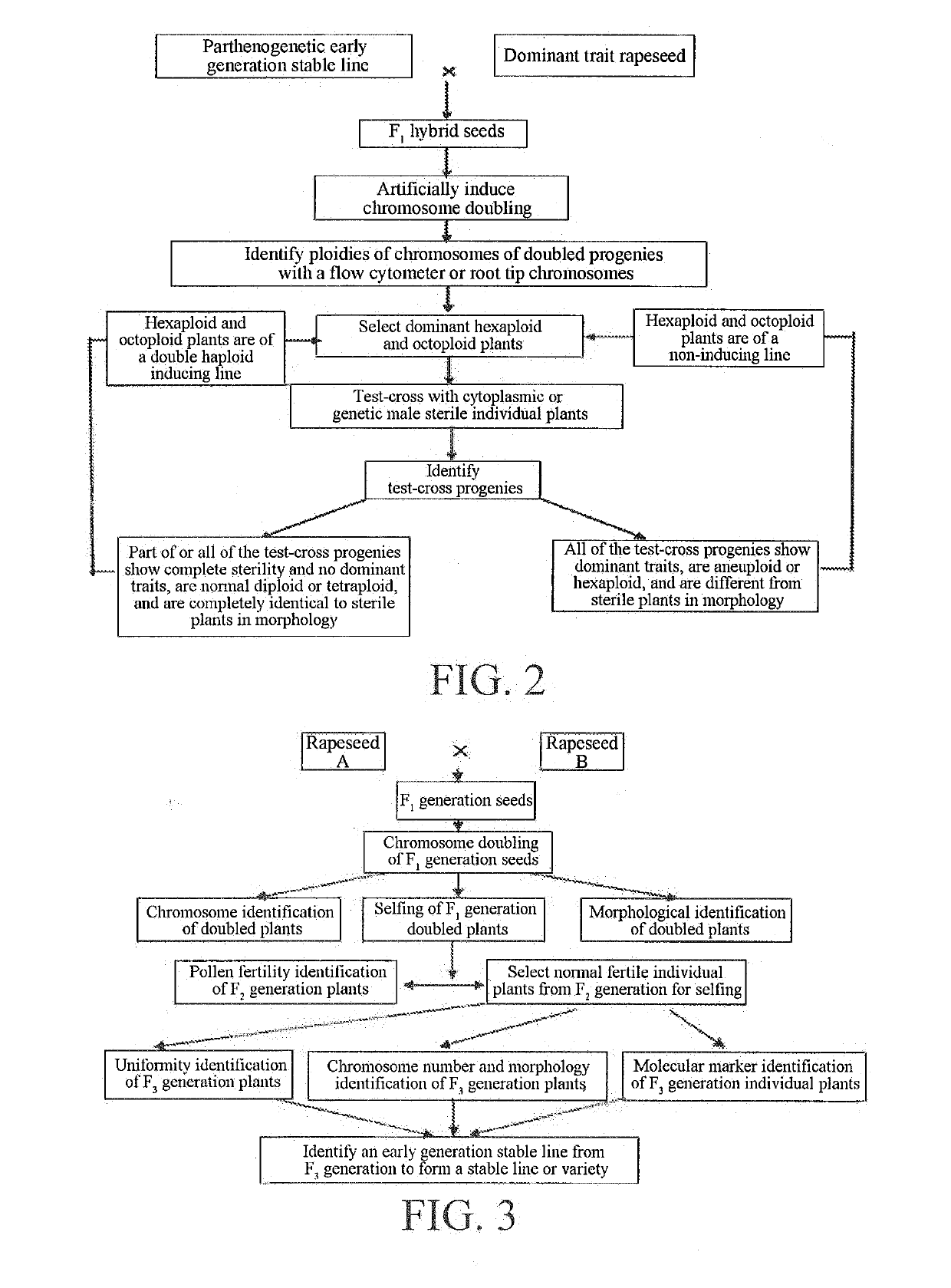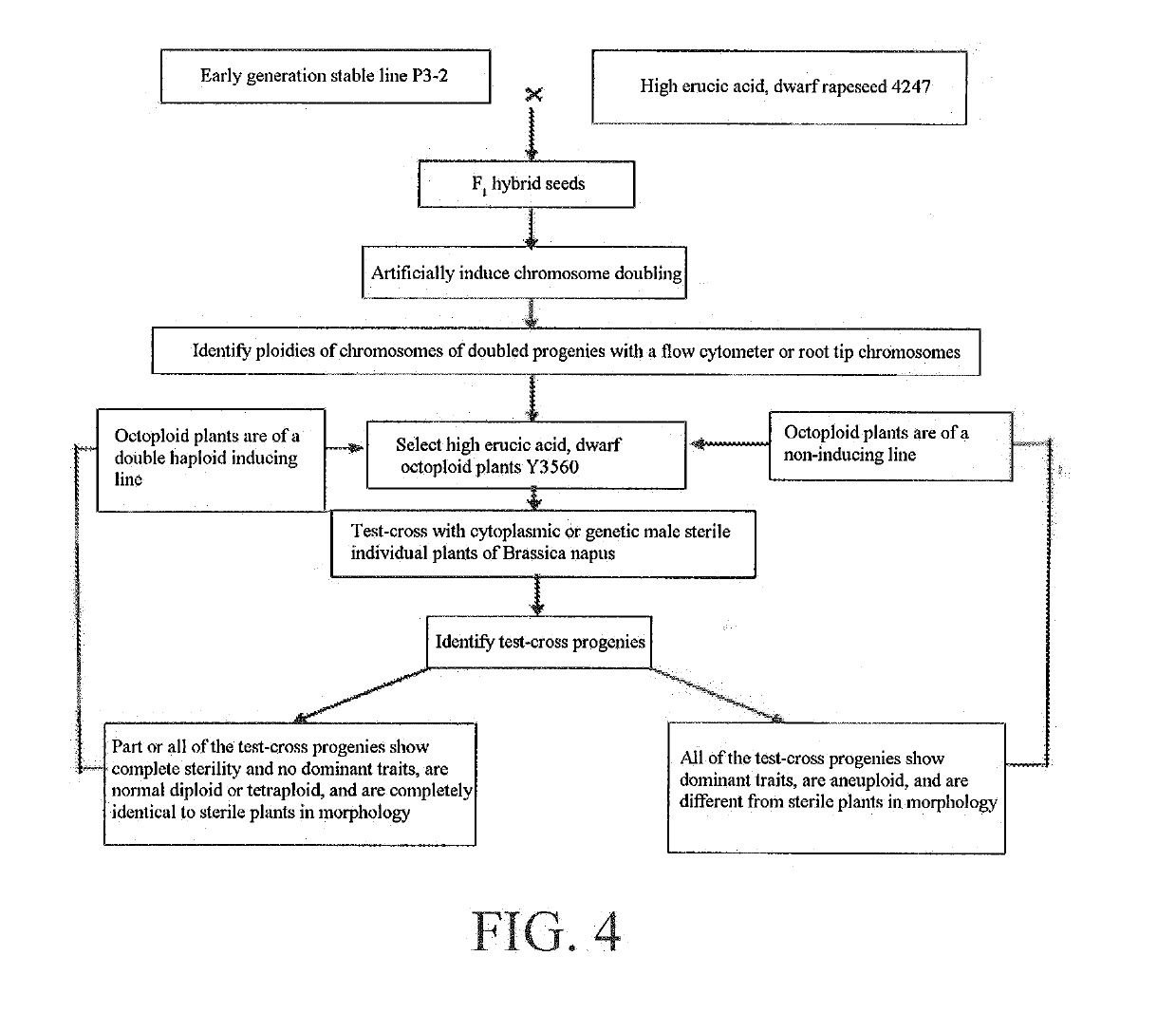Method for breeding brassica napus varieties and materials with double haploid induction line of rapeseed
a technology of brassica napus and induction line, which is applied in the field of agriculture, can solve the problems of difficult breeding of excellent hybrid varieties of brassica napus, and achieve the effect of stable progeny
- Summary
- Abstract
- Description
- Claims
- Application Information
AI Technical Summary
Benefits of technology
Problems solved by technology
Method used
Image
Examples
embodiment 1
[0062]Referring to FIG. 1, FIG. 2, FIG. 5 and FIG. 7, a Brassica napus double-low material “925100” was crossed with a restorer material “2150X Lijinte”, and excellent individual plants were selfed, separation was still present till the F9 generation, artificial castration was performed at the F10 generation, pollination was performed with a double haploid induction line of rapeseed Y3380 obtained by the applicant, and a large number of induced progeny seeds were obtained. The F11 generation (induced progenies) was planted and flow cytometry is performed, individual plants with normal fertility and ploidy (tetraploid) and without dominant traits (dwarf) of the inducing line were selfed by bagging, excellent individual strains were test-crossed with a polima cytoplasmic male sterile line “Rong A0068”, the test-cross progenies were completely fertile and the traits of the individual plants within the strains were consistent, indicating that the strains were of a restorer line. Therefo...
embodiment 2
[0101]Referring to FIG. 1, FIG. 2, FIG. 5 and FIG. 9, the Brassica napus early generation stable line P3-2 was crossed with Zhongshuang 11, the hybrid progenies F1 were artificially castrated and pollinated with the double haploid induction line of rapeseed Y3380 obtained by the applicant, the induced progenies were selfed by bagging, the F2 generation (induced progenies) was planted and subjected to flow cytometry, individual plants with normal fertility and ploidy (tetraploid) and without dominant traits (dwarf) of the inducing line were selfed by bagging, the purity of the F3 generation was identified, stable strains 4653 were selected and test-crossed with the polima CMS line “Rong A0068”, and the test-cross progenies were completely sterile, indicating that the induced stable strains 4653 were of a maintainer line, where the polima CMS maintainer line had high oil content (49% or more), good lodging and disease resistance, early maturity and complete infertility, and the steril...
embodiment 3
[0102]Referring to FIG. 1, FIG. 2, FIG. 4 and FIG. 10, Brassica napus Chuanyou 36 that was not easily obtained from restorer genes of ogura CMS was radish cytoplasmic three-line hybrid rapeseed approved in the upper, middle and lower reaches of the Yangtze River in Sichuan Province, which contained radish cytoplasmic restorer genes. Chuanyou 36 was crossed with P3-2 to obtain a convergent cross F1, and the F1 was castrated and pollinated with the double haploid induction line of rapeseed Y3560 obtained by the applicant. The F2 generation (induced progenies) was planted and subjected to flow cytometry, individual plants with normal fertility and ploidy (tetraploid) and without dominant traits (dwarf) of the inducing line were selfed by bagging, the purity of the F3 generation was identified, stable strains 4707 were obtained, at the same time, the pollen of 4707 was test-crossed with the stable radish cytoplasmic male sterile line Luo A100, the test-cross progenies were completely fe...
PUM
 Login to View More
Login to View More Abstract
Description
Claims
Application Information
 Login to View More
Login to View More - R&D
- Intellectual Property
- Life Sciences
- Materials
- Tech Scout
- Unparalleled Data Quality
- Higher Quality Content
- 60% Fewer Hallucinations
Browse by: Latest US Patents, China's latest patents, Technical Efficacy Thesaurus, Application Domain, Technology Topic, Popular Technical Reports.
© 2025 PatSnap. All rights reserved.Legal|Privacy policy|Modern Slavery Act Transparency Statement|Sitemap|About US| Contact US: help@patsnap.com



